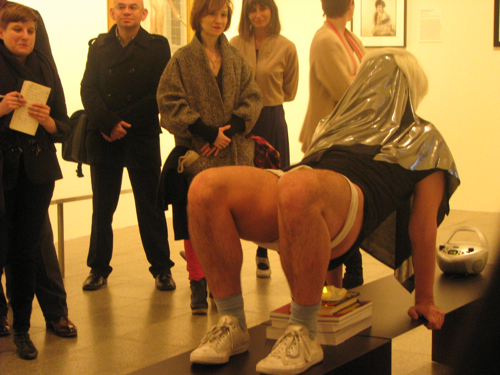
Gutierrez performing an excerpt from “Retrospective Exhibitionist” while squatting over an electric candle. Yours truly on the far left making a face of disapproval at the restriction. Courtesy Metropolitan Museum of Art.
On November 29, 2012, I had the special opportunity to attend choreographer Miguel Gutierrez‘s performance or “guided tour” of Regarding Warhol: Sixty Artists, Fifty Years at the Metropolitan Museum of Art. Gutierrez sat down with me to discuss the transposition of his dances onto the the museum structure, his thoughts on Warhol, and the myth of the icon.
Marissa Perel: As a choreographer who usually has control over the environment in which you perform, what was it like for you to negotiate the context of performing in an exhibition?
Miguel Gutierrez: For a moment, I was like, “God, do they know who they’ve asked to do this?” I’m someone who needs space, someone who makes sounds, someone who improvises, which means that I can’t always predict what’s going to happen!
I tend to approach being curated into visual art contexts as a performer with suspicion because the things that I normally need to do what I do are not available to me. As the date [of the performance] approached, I was told that I couldn’t plug an amp into the wall and couldn’t have an open flame, which I use for one piece. I was required to provide a detailed outline of what I was going to do, but I had very little time in the actual space to rehearse.
I didn’t tell them if I was going to be nude because I knew they’d say no. I wasn’t sure if I was going to be nude, but I thought I would probably try. Who doesn’t want to be nude at the Met at some point in their lives?
The important thing to think about is whether you are entering into an experience where you feel you’re being confronted with yeses or nos, and how you choose to deal with the yeses and the nos—really, the nos—often determine what’s possible or not possible, and then also, do you want to work with that restriction as content?
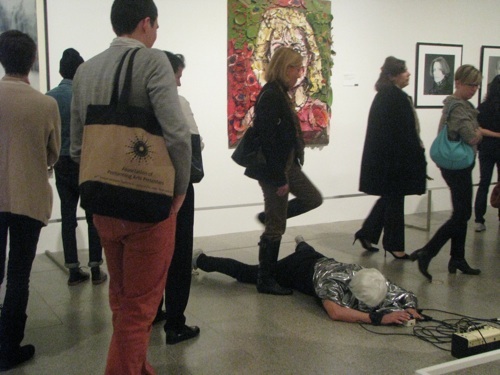
Gutierrez sings “Won’t You Please Beat It Into Me” while playing a distortion pedal and posing an obstacle for the audience. Courtesy Metropolitan Museum of Art.
MP: I noticed that you used excerpts from different pieces you’ve made over the course of your career to infiltrate areas in the exhibition. It was as if you were, conceptually, working in response to Warhol’s process, using performance ready-mades to reflect back at the objects. I don’t think the visual art viewers that were present had an awareness of your history to understand this parallel.
MG: As a person coming from performance, you constantly feel ahistorical. You constantly feel like no one actually has a sense that you’ve done something before, and your work has its own history in relationship to other kinds of histories. There’s this feeling of, “Ooh, what’s this?”
Why is there this surprise in discovery when you’re talking about people and a way of art making that has been present for such a long time? I realized in my anxiety about making something new for the Warhol performance that I was caught up in this idea of having to make something new. Everything in the exhibition preexists, so why did I fee pressure to come up with something new to respond? I have this body of work that I’ve made. Most people aren’t going to know that.
There’s always this sense of reverence in museums around preservation, and representation of history when it comes to objects. So, I decided to do that with my own body of work. It gave me confidence to re-perform parts of performances I have made. It provided a way for me to have a sense of agency inside of a context that can feel so powerless to a performing artist.
One of the things that is interesting, compelling, and problematic about being a body in that space is the irreverence that your body poses. The museum can install a sculpture of a naked ass on the wall, but you can’t actually be a naked ass in the room!
The artwork can represent death and loss and horror, but how can the performer actually be death and loss and horror? With Felix Gonzalez-Torres’s Untitled (Portrait of Ross in L.A), so many people see that piece and don’t even realize they actually can take the candy. That’s the whole notion of wasting and dying, AIDS and loss, and his partner dying. It seemed like the perfect thing to really give it to the audience with my body.
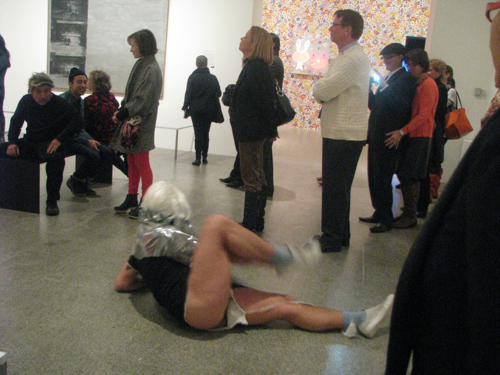
Gutierrez undressing in an excerpt of “Retrospective Exhibitionist,” though it appears to be noticed by few audience members. Image courtesy of the Metropolitan Museum of Art.
MP: You gave it to the audience verbally too, reading your “Fuck you, Andy Warhol” poem in the room with Warhol’s pillows for Merce Cunningham’s RainForest.
MG: I love Rainforest. It’s one of my favorite dances ever. I love the score. I love the whole thing. It’s funny, because I have a deep reverence for that whole collaboration. But even from the day I was asked to do this, I had been walking around thinking I was so sick of Andy Warhol!
The way in which he is untouchable makes it feel like there’s nothing that can’t get tied to him. The poem is about that historical oppressiveness that comes from his stature. My criticism of Warhol is that he dealt with a very particular kind of person in his work and he was definitely making it for a type of people. Whether he was aware of it or not, he definitely contributed to an affective discourse which you could say, has been passed down by hipster, or more like white, emotionless art.
As an artist who identifies himself as a person of color, a person with Latin American heritage, it’s impossible for me not to see that and critique it. There’s this idea that Warhol is in everything–I protest. There are things he’s not in and it’s important to name them. Was he a feminist? No. Some of his work portrayed queerness, but it’s a very male queerness. It’s the camera lingering on the male form. If there are nude women in his work, it’s not a loving gaze. I’m not faulting him for that per se, because the work is the work, but to pretend otherwise would be strange.
I was reading his 1975 autobiography, Andy Warhol from A to Z and Back Again; it’s brilliant and infuriating. It’s so pithy. That pithiness of his, which he framed and sold, is oppressive to me. It’s fortune cookie thinking. Inside of it, there’s a flatness. It’s like, “Oh yeah, that’s pretty obvious. And isn’t it exciting that he’s naming it!”
MP: What about Warhol’s “fortune cookie” language stood out to you in your research?
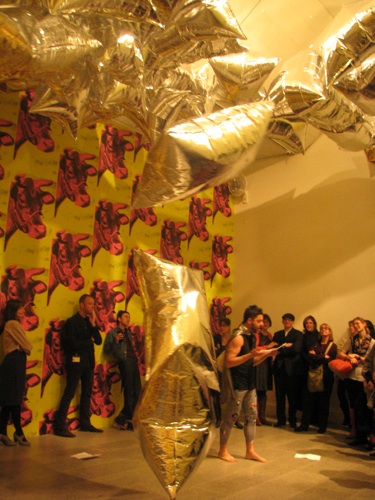
Gutierrez performing “Fuck You, Andy Warhol” as the culmination of his guided tour. Warhol’s balloons for Merce Cunningham’s dance “Rainforest” (1968) circulate through the room. Courtesy Metropolitan Museum of Art.
MG: I made a song called “Like Money on The Wall” out of his quotation. [sings] Say you’re going to buy a two hundred thousand dollar painting / I think you should take that money / tie it up and hang it on the wall / then when someone visited you / the first thing they would see is the money on the wall.
That’s genius. This idea that instead of getting a two-hundred thousand dollar painting, just tie that money up on the wall because that’s basically what you’re trying to show people. I do think it’s really satisfying to hear that named. Though it’s funny because I was singing the song next to an actual Warhol on the museum’s wall.
Even as he was playing into this intense bourgeois notion of artist and patron and commission, he was completely aware of its implications, and how it can belie the process of making work, exposure, need, and voice.
MP: And motivation.
MG: Yes, and who has access and who doesn’t.
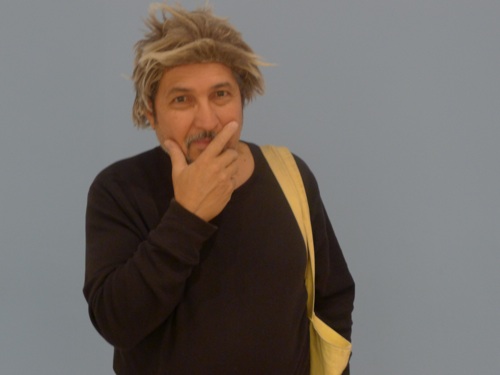
A museum staff member portrays a mock Warhol for Gutierrez’s performance. Image courtesy the Metropolitan Museum of Art.
MP: How do you relate the concept of the icon to your own artistic career?
MG: I’m never going to have that experience of the car that shows up and whisks you off! That’s never going to happen. That’s not really part of the economic structure of what I do. I’m in the more labor-filled corner of things. I read this interview with Sharon Needles, the queen who won “RuPaul’s Drag Race” last season, and she says that the funny thing about fame is that it’s not a thing you feel, it’s a thing that other people around you feel about you. You’re walking around and you’re still that weird, insecure person. I totally identify with that. I have that experience sometimes where I walk into a place and people have an idea of something, but I’m just worrying if the show was good or not, and if my next thing’s going to be better. That’s what I’m concerning myself with.




Pingback: Performance in Museums | An Animal in the Archive